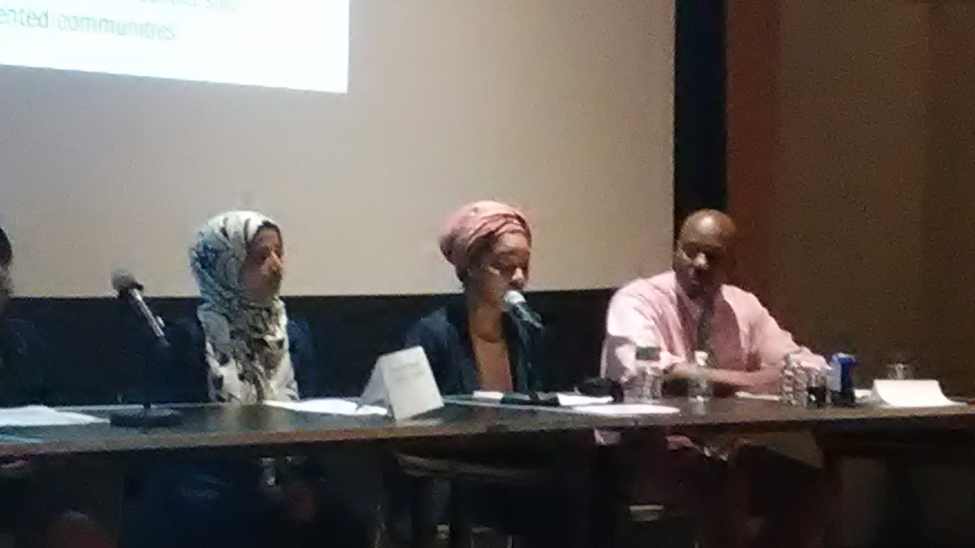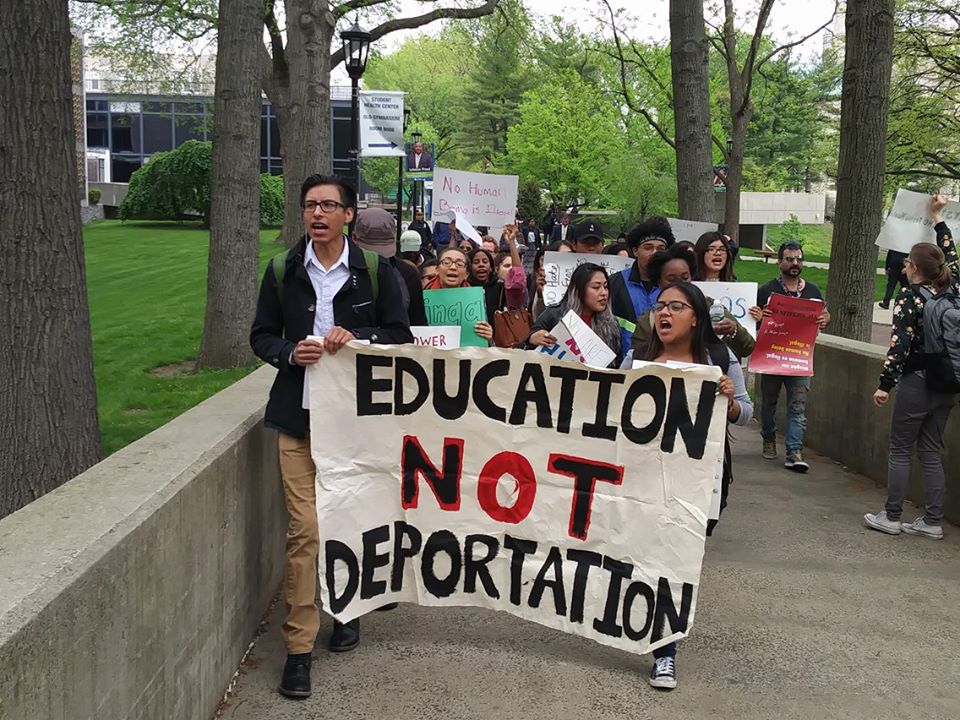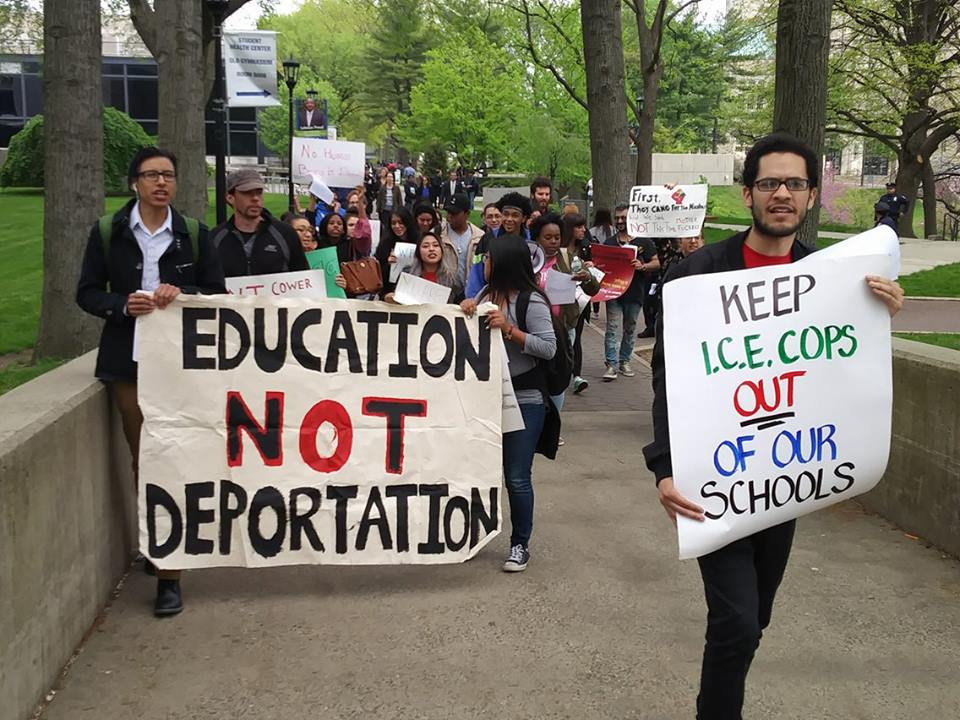Lehman Undergrads Showcase Activism through Academia
By Jean Carlos Soto
Activism in Academia. Photos by Jean Carlos Soto.
The Activism in Academia Symposium, held on April 7 at the Segal Theater of the CUNY Graduate Center, offered academics and selected students from across CUNY an opportunity to discuss and present work that challenged what Lehman English professor Olivia Moy called the “false dichotomy” between activism and academia. This dichotomy arises from the belief that the “contemplative life” of academia, especially in the humanities, has no real-world value nor impact on society, whereas the “active life” of activism inherently does.
The symposium consisted chiefly of department chairs from various CUNY campuses, whose interdisciplinary work touched on a range of topics. However, the student panels of five Lehman undergraduates were the highlight of the conference, exemplifying the activism the symposium’s organizers had sought to address. The Lehman undergraduates used the platform to present theses reflecting academic research that tied into issues both personal and social.
The first half of the student panels focused on the Black-authored text. C. Lionel Spencer, a Lehman English major and Africana studies minor, examined the academic value of hip-hop in presenting “strong positive Black leadership,” a representation he seldom found in the literature of his English classes. As an example, he analyzed the lyrics of rapper Kendrick Lamar’s song “King Kunta,” which, as Spencer stated, has us “re-imagine that [Black] history does not begin as slave, but as Black royalty.”
Panelist Nadia Floyd also touched on representation, primarily on the marginalized voice of the Black woman. Drawing from the characters of Toni Morrison’s “The Bluest Eye” and Floyd’s own experiences in classrooms over the years, Floyd presented on the need for Black women to execute and reclaim their voices in a classroom setting. Fittingly, the conference allowed Floyd to realize such a situation.
“It was great to relate to people around the room,” recounted Floyd, a Lehman double major in English and Psychology, “[and] to have our voices heard.”
“They blew away every other panel,” said Moy, who coordinated the gathering with Dhipinder Walia, a fellow Lehman English professor, “and they showed every other panel how much we have to learn from them...what they had to say today really educated all the faculty and tenured emeritus people here...to show that it’s already equal, it’s just that the platforms haven’t been there.”
The coordinators wanted a diverse audience, because they felt that academic conferences typically draw a homogenous crowd. In contrast, the audience at this activism conference was diverse in terms of education, age, race, and ethnicity. However, the panels of faculty presenters were less so.
“The only thing that was a bit weird to me,” said Floyd, “was that most of the panelists weren’t people of color. I mean, there was the department chair who was Caribbean, and there was Jorge [Valldejuli], but other than that they were talking about issues that directly affect us, the urban, and I thought it was weird that they were speaking from this privileged space, even though they have ownership of what they researched. That unsettled me a little bit that I didn’t see more people of color, and that shows how academia really isn’t diverse, in terms of faculty.”
On the panel of current and former English Department chairs, John Jay professor, AllisonPease, likewise suggested that the conversation of diversifying the curriculum should include discussion on who is teaching the material, i.e. more diverse hiring.
According to CUNY’s “Fall 2016 Staff Facts,” 60.5 percent of the total full-time faculty across CUNY was white, 12.2 percent was Black, and 8.9 percent Puerto Rican or Hispanic, with part-time faculty just slightly more diverse: White 58.6 percent, Black 16.1 percent, Puerto Rican or Hispanic 10 percent.
In the same year, Lehman reported a greater disparity between full- and part-time faculties: the former was 66.5 percent White, 10.2 percent Black, and 12.8 percent Hispanic/Latino. Part-time faculty, who receive a fraction of the full-time faculty’s salary and resources, was 52.4 percent White, 20.4 percent Black and 15.9 percent Hispanic/Latino. Although Lehman prides itself on its “diversity and commitment to multicultural understanding,” its students may struggle to see that in who is teaching them.
Some of the presentations during the second half of the student panels addressed the experience of navigating academic settings where their identities were not fully welcomed, and offered examples of how their presence there could be a kind of activism. Lehman undergrads Alegna Santos, and Sheema Alamari related how they reconciled religion with other facets of their identities in class room settings, followed by Lehman junior Ndeye Fatou Coundoul passionately reading her poem, “A Letter to My Future Daughter.” Alamari also openly pondered how women who identify as both feminist and Muslim could balance and embrace both worlds.
“Here’s the way I do it,” began Alamari, “I don’t march on the streets, but I do so through the choices of what I read and write on campus. In fact, I take on all these feminist ideas from professors and classes which have shaped my identity through all my college experience.”
Along with bridging the gap between activism and academia, many panelists, like Alamari, indicated that activism can take various shapes besides the stereotypical, such as marching, demonstrations, and boycotts.
For Professor Joyce Harte, chairperson of the English Department at BMCC (the Borough of Manhattan Community College), activism can even come in the form of college enrollment.
“Many are first [in their families] to go to college,” said Harte,“and the fact that they are there embodies activism.”
Floyd echoed this sentiment. “I learned that my pen was my tool in pursuing social change,” said Floyd as she presented. “Being an honor student in both majors [English and psychology] is an act of activism for me, because hardly anyone in my public life expected these feats from me.”
One audience member, Marceo Bravo-Lopez, 22, a double major in English and philosophy at Lehman, said he also uses the act of writing newspaper articles on topics like policing policy to participate in what he considers “indirect activism,” more so than the “direct activism” of demonstrations or protests in a public space. Another audience member, Nisha Varughese, a double major in English and education at Lehman, said she finds activist value in her educating others, but shies from the label “activist” as a fear of judgement often holds her back whenever it comes time to speak in a large group.
Even Floyd is hesitant to call herself an activist. “I feel like an activist,” she said, “[but] it’s a term that’s very glorified, it’s very loaded, and I’m still sorting out my identity. So, it’s sort of hard for me to say ‘activist’... I can say it, but I can’t say it at the same time.”
“Activism starts at the heart and mind,” said Spencer, “and moves to the feet and hands. So, whether it’s holding a protest sign or pen, marching on Washington or dancing with Alvin Ailey, we must all choose what we’re going to do with what we learn.”
May Day Protest Attempts to Spark Change
By Juan Vasquez
Lehman Students march during the May Day protest. Photo by Juan Vasquez.
Cries of “No borders! No nations! No more deportations!” echoed through the Lehman quad as a protest organized by the International Socialist Organization and the Lehman D.R.E.A.M. Team fought for sanctuary campuses. Official sanctuary status would mean the school would have no legal obligation to comply should Immigration and Customs Enforcement officers enter campus with a warrant to arrest all undocumented students.
“The D.R.E.A.M. Team has pushed for sanctuary campus resolutions which have been denied by previous Student Government Associations in the past,” Jona Kerluku, 22, a protester and a member of student government said. “The [CUNY] University Student Senate also passed a Sanctuary Campus Resolution to encourage the chancellor to support students who are undocumented. However, this resolution at Lehman has not passed committee for the College Senate and we have not yet established that Lehman College, and even CUNY at that, is a true sanctuary place for students.”
One observer of the entirety of the campus protest, Lehman student Liza Giralado, said that the protest was “something that should happen.” However, she was afraid to join, she added, because “I’m actually an immigrant...so I am kind of afraid that if I protest the cops are going to come and I just can’t afford to get arrested because I have to keep my nose clean for the citizenship.”
Two members of the Lehman D.R.E.A.M. Team, Denise Acevedo and Flor Reyes, differed as to whether or not the protest had made an impact.
Avecedo thought not, arguing that much more was necessary. “In order to make a difference we must all have an understanding of why May Day is important,” she said, “and that comes with a lot of unlearning and learning to do. I want Lehman administration to fully support and stand next to us and not be bystanders like they did today.”
Reyes, however, was much more optimistic. “Yes, quantity over quality... The protest today was just a mere example of actions that should be taken everywhere in order to better our future.”








